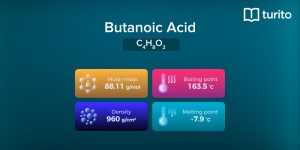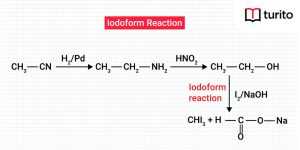Acetic Acid (CH₃COOH)
Acetic acid is a carboxylic acid-containing chemical compound. The acetic acid formula CH₃COOH has a methyl group linked to a carboxyl functional group. Ethanoic acid is its IUPAC name. Acetic acid, the primary component of vinegar, has been recognized since antiquity. The vinegar solution comprises acetic acid and water, with ethanoic acid ranging from 5% to 20% by volume. The acetic acid in vinegar is accountable for its strong odor and sour flavor. It is important to understand what acetic acid is and what its physical properties are.
What is Acetic Acid?
Acetic acid sometimes referred to as ethanoic, vinegar, ethylic, and methane carboxylic acid has the formula CH₃COOH. Acetic acid is a result of fermentation that gives vinegar its distinctive odor. Acetic acid is a physiologically relevant metabolic intermediate in body fluids and plant juices.
Glacial acetic acid is a concentrated acetic acid solution. It generates ice-like crystals at temperatures below 16.6 degrees Celsius and has several uses. Glacial acetic acid is often employed in analytical chemistry to evaluate weakly alkaline substances. Acetic acid has a variety of additional essential applications. Its applications extend to various industries.
Structure of Acetic Acid (CH₃COOH)
The second most basic carboxylic acid is ethanoic acid. The following is acetic acid’s molecular structure:
- The vinegar chemical formula is CH₃COOH. It is the same as acetic acid because vinegar is a dilute form of acetic acid. The molecular formula and the chemical formula for vinegar will be identical.
- There is a network of molecules in the solid state of acetic acid, with individual molecules, joined by hydrogen bonds.
- Dimers are discovered in their vapor state at temperatures of 120°C.
- Dimers are detected in a dilute solution when it is present in the liquid phase.
CH₃COOH Molar Mass
The molar mass of acetic acid is calculated to be 60.05 g/mol. It may be computed as follows:
(2 × 12.011) + (4 × 1.00794) + (2×15.999) g/mol
= 60.05 g/mol
Physical Properties of Acetic Acid
The following are some of the most notable features of acetic acid:
- Ethanoic acid, often known as acetic acid, has a strong vinegar odor and a sour flavor.
- It is a colorless, transparent liquid.
- It boils at 391 degrees Kelvin.
- It has a liquid density of 1.049 g/cm3.
- It may be mixed with water, alcohol, or ether.
- It dissolves in water due to the evolution of heat and volume contraction.
- When it comes into touch with the skin, it is corrosive and causes blisters.
- It contains sulfur, iodine, and a variety of other chemical substances.
Chemical Properties of Acetic Acid
The following are some of the most notable chemical features of acetic acid:
- Acetic acid loses one hydrogen molecule due to the carboxyl functional group. This causes a big ionization of the compound, as shown by the reaction: CH₃COOH ⇌ CH₃COO⁻ + H⁺
- Acetic acid’s acidic character results from the proton discharge mentioned by the equilibrium process above.
- Acetic acid’s conjugate base is acetate (CH₃COO⁻).
- As may be observed from the pH of an ethanoic acid solution at 1.0M concentration, acetic acid does not entirely dissociate.
- Acetic acid is a polar, protic solvent with a liquid dielectric constant of 6.2.
Acetic Acid Reactions
Nearly all carboxylic acid reactions involve acetic acid
- When heated above 440°C, acetic acid decomposes to produce either methane and carbon dioxide or wethanol ethanone, as shown by the equations.
CH₃COOH + Heat → CO2 + CH4
CH₃COOH + Heat → H2C=C=O + H2O
- Certain metals, such as magnesium, iron, and zinc, corrode when introduced to acetic acid. Acetate salts are formed as a result of this process. When magnesium interacts with acetic acid, magnesium acetate and hydrogen are formed, as shown in the equation.
2CH₃COOH + Mg → Mg(CH₃COO)2 (magnesium acetate) + H2
2Ca + 2CH₃COOH——-> (CH₃COO)2Ca (calcium acetate) +H2
- Acetic acid interacts with alkalis to generate acetate salts, as shown in the equation.
CH₃COOH + KOH → CH₃COOK + H2O
- Acetate salts, H2O, andCO2, are the products of the interaction with carbonates.
2CH₃COOH + Na2CO3 (sodium carbonate) → 2CH₃COONa + CO2 + H2O
CH₃COOH + NaHCO3 (sodium bicarbonate)→ CH₃COOHNa + CO2 + H2O
Uses of Acetic Acid (CH₃COOH)
- Ethanoic acid is used to make a variety of paints, polymers, rayons, silk, and fragrances.
- Its most common application is table vinegar. Acetic acid is the primary ingredient in vinegar. Hence, the Vinegar chemical formula is the same as acetic acid, i.e., CH₃COOH.
- It is employed as a topical irritant in medicine.
- It is also utilized as a coagulating agent in the rubber sector.
- It aids in producing acetate, acetone, and esters, which are useful in various industries.
- It is commonly used to manufacture VAM (vinyl acetate monomer).
- It is administered intravenously into the tumor during cancer therapy.
- Acetic acid has good solvent characteristics and may generate miscible mixes with polar and nonpolar molecules. As a result, it is a vital industrial solution. It is commonly utilized in the production of dimethyl terephthalate (DMT).
- It is an aggressive micro bactericidal disinfectant that works against most other microorganisms.
Applications of Acetic Acid
Acetic acid has several uses. Consequently, the acid is employed in a range of applications and used as a food preservative (vinegar). Some of the most prevalent and notable uses are as follows:
In Industrial Usage
Acetic acid is used in a range of industrial procedures to create compounds. It is also employed as a chemical reagent to create a range of chemical substances such as acetic anhydride, vinyl acetate, ester, vinegar, etc. It may also be used as a solution for crystallization, making it beneficial for the purification of organic compounds.
In Medicine
Acetic acid has a wide range of medicinal uses. Its principal use is as an antimicrobial against germs such as streptococci, pseudomonas, staphylococci, enterococci, and others. Acetic acid is often used to cleanse the bladder of people with urinary catheters to prevent obstruction and disease. Acetic acid is incredibly beneficial against skin infections brought on by Pseudomonas strains that have developed antibiotic resistance.
As a cervical cancer screening tool, it is also highly helpful. The cervix is exposed to acetic acid, and the test is successful if certain parts become white. Additionally, it is employed in chromoendoscopy to identify stomach cancer in its earliest stages.
In the Food Industry
In the food industry, acetic acid is most commonly employed in industrial preserving processes and sauces such as ketchup, mustard, and mayonnaise. It also helps flavor a wide range of dishes, including salads. Furthermore, vinegar may react with basic compounds like baking soda, generating a gas that helps bakery goods rise.
At Home
At home, a dilute acetic acid solution is commonly used as vinegar. As we know, vinegar is frequently used in the household for housekeeping, washing, cooking, and various other tasks. Farmers sprinkle acetic acid on cow fodder to prevent bacterial and fungal development, preventing diseases.
Conclusion
Besides formic acid, acetic acid is the second simplest carboxylic acid, and methyl is its functional group. It is a significant chemical and industrial chemical produced largely for creating artificial fibers and textiles, polyvinyl acetate for wood glue, and ethyl cellulose for fil
Acetiche acetic acid in diluted form is frequently used in homes as a descaling agent to help remove limescale from metallic household components. Acetic acid is regud by the code E260 in the food sector as a sauce and an acidity adjuster. The acetyl group, produced from acetic acid, is essential to all living creatures in biology. It is essential for synthesizing fatty acids and glucose when linked to coenzyme A.
Frequently Asked Questions
1. What is acetic acid’s purpose?
Acetic acid in vinegar is by far the most common. Additionally, it is very helpful in creating the monomer for vinyl acetate (VAM). This molecule is a necessary ingredient in the creation of glue and acrylics.
2. Is acetic acid strong?
No, CH₃COOH is not a strong acid. Only when it reacts with a strong base does it dissociate entirely. Despite being weak, acetic acid’s pure state is highly corrosive and can cause irritation and blisters. Long-term occupational exposure to sour acid fumes at 10 ppm for seven hours or more can irritate the eyes, nose, and throat.
At 100 ppm, there may be respiratory discomfort and potential lung, eye, and skin damage. Long-term exposure to acetic acid can cause respiratory tract infections, conjunctivitis, tooth erosion, asthma, and tonsillitis in workers. Therefore, the acid concentration has the greatest influence on the risk.
3. How is acetic acid (CH₃COOH) made?
It may be made by mixing methanol with hydrogen iodide to create methyl iodide, which can then be combined with carbon monoxide to create acetyl iodide. Acetyl iodide hydrolyzes to produce acetic acid.
CH₃OH (methanol) + HI (hydrogen iodide) → CH₃I (methyl iodide intermediate) + H2O
CO (carbon monoxide) + CH₃I → CH₃COI (acetyl iodide)
H2O+CH₃COI→ CH₃COOH (acetic acid) + HI

Relevant Articles
Butanoic Acid – Structure, Properties, Uses
Butanoic Acid The carboxylic acid, butanoic acid, has the structural …
Butanoic Acid – Structure, Properties, Uses Read More »
Read More >>What is Iodoform? Characteristics and Uses
Iodoform The formula for Iodoform is CHI3. It is biotic …
What is Iodoform? Characteristics and Uses Read More »
Read More >>Lattice Energy – Explanation, Factors & Formulas
Lattice Energy Lattice energy evaluates the intensity of the ionic …
Lattice Energy – Explanation, Factors & Formulas Read More »
Read More >>Lead Acetate – Definition, Properties, Uses
Lead Acetate Have you ever licked lipstick when you sketch …
Lead Acetate – Definition, Properties, Uses Read More »
Read More >>




















Comments: